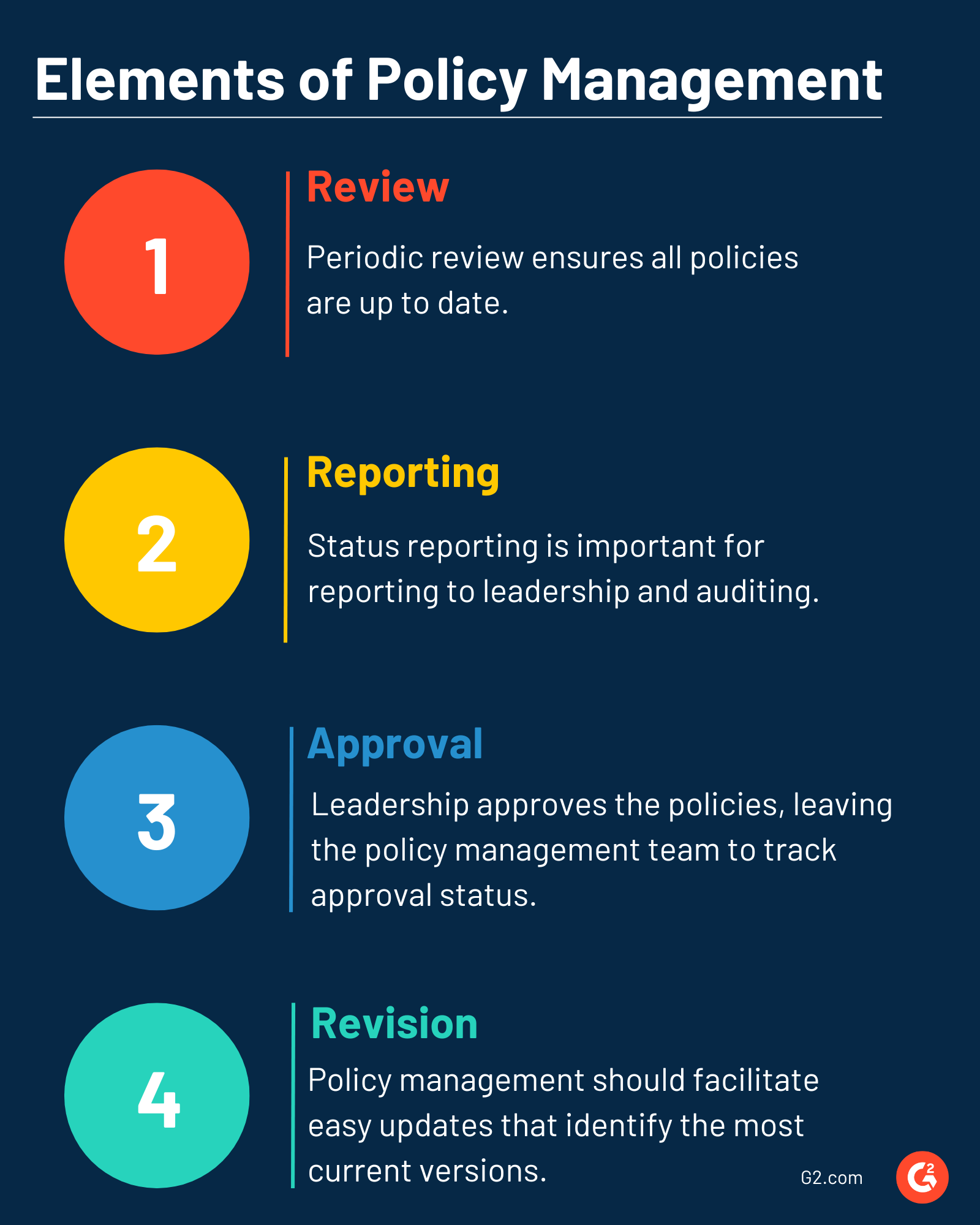What is policy management
Policy management is the process of creating, reviewing, approving, organizing, and distributing all policy and procedural documents within an organization. Policy management allows companies to adapt as needed, ditching the old policy binder for a modern, easily digestible format.
Employees in an organization need to keep up with the latest threats, risks, and data and work according to the applicable rules and regulations. Policy management helps organizations ensure all employees know how to operate and comply with their policies.
Policy management software helps users manage policies from creation to approval and every step in between, according to the organization’s established workflow. Policy management allows team leaders to distribute to and share policies with all relevant employees. This process further helps organizations comply with external regulations and respond rapidly to situations like customer escalations or security infringement.
Types of policy management
There are various types of policy management, some more effective than others. The type a company chooses depends on its size, budget, and preference.
- Paper-based: Outlines policies on physical paper, organizing them using old-fashioned methods like filing cabinets and binders. This method is generally considered risky, as paper policies are easy to lose or damage, prone to security risks, and time-consuming to update. Furthermore, frequent printing can be expensive.
- Mixed media: A blend of paper and digital solutions. It helps reduce paper usage and inefficiency. This type of policy management allows organizations to collaborate and distribute policy documents a little more easily than paper-based. Mixed media policy management usually involves uploading documents to shared intranet drives, signing and tracking documents digitally, and collaborating using tools like Gmail, Google Workspace, Microsoft Teams, and so on. This method is safer than the paper-based method but is still prone to inefficiencies like outdated or duplicate documents. Employees need to update these policies manually.
- Digital-based: Uses cloud-based software to organize, update, and distribute documents as efficiently as possible. Software allows organizations to automate workflows and update policies in real time, eliminating the need to distribute new policy documents every time something changes.
Benefits of using policy management
Managing policies help teams stay up to date with the latest versions, so employees stay compliant in all situations.
- Easy updates. Policy management helps prevent the loss of critical updates and new policies passed on from managers to employees.
- Risk management. Employees who know what is expected of them to comply with relevant policies reduce the risk of non-compliance for their organizations.
- Save time with automated workflow. Policy management in large organizations closes the distance between policymakers and employees and gives policymakers more influence. It also helps teams automate workflows to save time.
- Easy reporting. Policy management documents all policies and revisions in one centralized location, enabling easy reporting.
- Accountability transparency. Policy management helps track which employees made changes and makes the process more accountable and transparent.
Basic elements of policy management
Policy management requires a system to maintain and update documents. This is typically referred to as a policy catalog. The more advanced the catalog, the more beneficial it is to the organization.

The basic elements of a good policy management system include:
- Policy review: Periodic review ensures all policies are up to date. This requires employees and managers to share, edit, and approve the documents timely.
- Policy reporting: Status reporting is important for reporting to leadership and auditing. Policy management should allow for frequent and easy reporting.
- Policy approval: The leadership approves the policies, leaving the policy management team to track each policy’s approval status.
- Policy revision: Policy management should facilitate easy updates that identify the most current versions.
Policy management best practices
The policy management system must be set up for success and regularly maintained for positive results. Follow these best practices:
- Use software. Companies without an organized policy management system struggle with policy consistency and communication. Plus, manually distributing policies on paper, spreadsheets, or basic cloud storage systems leaves too much room for error. With software, organizations can automatically update company-wide policies. Policy versions are centrally located, providing constant access to all stakeholders involved. Organizations also don’t have to worry about juggling multiple policy versions, as the software always shows the updated version.
- Prioritize consistency. Policy management needs to be consistent so that employees understand the importance of policies. Proper policy management provides managers with consistent guidelines for disciplinary action, imperative for fair treatment.
- Make policies accessible. Policies should be easily accessible to employees across the organization. Giving employees the ability to search and find the policy they’re looking for helps them know exactly what the policies expect them to do so that they can respond to situations accordingly.
- Provide training on policies. Training based on company policies helps employees contextualize policies, improving long-term policy compliance management.
- Review often. Reviewing and updating policy is a big part of policy management. Policies can often change, and a good policy management system keeps up with these changes.

Martha Kendall Custard
Martha Kendall Custard is a former freelance writer for G2. She creates specialized, industry specific content for SaaS and software companies. When she isn't freelance writing for various organizations, she is working on her middle grade WIP or playing with her two kitties, Verbena and Baby Cat.

